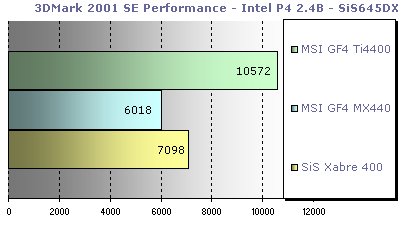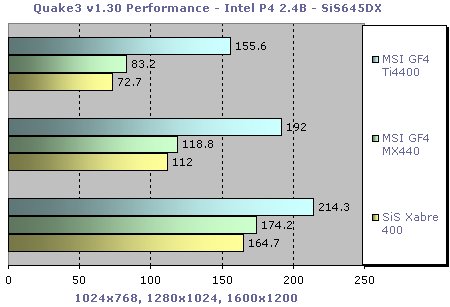|

We'll be taking a look at 3 of our 5 benchmarks on this page of performance analysis, 3DMark 2001 SE, Aquamark and Quake3. To start with, lets take a look at the 3DMark 2001 SE results. Since Xabre does Pixel Shader 1.3 in hardware and 3DMark 2001SE relies on shader hardware acceleration for good results, we should see Xabre do well here against NV17.

We can ignore the Ti4400 result since it's in a different class of GPU in the high end segment and it walks over Xabre and NV17 here. What's interesting is that straight off, Xabre takes an early lead over NV17. It's worth noting that the Xabre driver reported enough back to 3DMark upon the driver query that 3DMark is happy to run the Nature test on Xabre and it runs quite well on the test hardware.
As you know, the Nature test is only run by 3DMark on hardware it considers capable enough in the acceleration of pixel and vertex shader and it does this by querying the DirectX driver for the card and asking the driver for the cards capabilities. Based on the returned information, Nature will be run or skipped.
Nature uses pixel shader for the water effects and it runs very well on Xabre on the 2.4B/DDR333 platform. Performance isn't stellar but it's what enables Xabre to take the lead here since NV17 can't run the Nature test. While any vertex shader programs are done on the host processor, given a fast enough host processor, shader heavy programs should run faster on Xabre than NV17.
So an early lead for the little budget SiS card over its main rival! On to Aquamark.
Again, Aquamark is fairly shader heavy and again it reports that Pixel Shader hardware is present. Check the following snippet of the output from Aquamark before we move on to the graph.
RESOLUTION : 1024x768x32
FSAA : NONE
PIXELSHADER: YES
TEXTURE : 24MB
On NV17, that "PIXELSHADER: YES" line reads "PIXELSHADER: NO" so further proof that Xabre does Pixel Shader in hardware for the sceptics among you. Onto the results where Xabre should give NV17 a handy beating.

Ignoring the comparison Ti4400 result, Xabre is approximately 25% faster in Aquamark than the test GeForce4 MX440 card from MSI. The offloading of the pixel shader programs from the CPU where they are all run with NV17 lets the Xabre take another victory from its competitor. Being the only hardware in this class that implements any onchip DX8 class shader hardware, Xabre does well here.
Finally in our benchmarks on this page, Quake3. Quake3 is a fairly old benchmark now. The game, written in OpenGL, does very well on NVIDIA hardware in part due to the hardware and also down to efficient drivers from NVIDIA. We've established that Xabre is more than a match for NV17 when DX8 class shaders are used by the application, but Quake3 is a different test all together. Multi texturing and memory bandwidth are tested here, along with driver efficiency. The results should be interesting.

Here, NV17 beats Xabre in all resolutions, by as much as 15% in the highest resolution of 1600x1200 where the card is working hard and memory bandwidth performance becomes a bottleneck. NVIDIA's highly tuned drivers give NV17 the edge here where you might expect Xabre to win given the previous two results. There's no doubting that Xabre can give NV17 a good fight but not here.
Performance wasn't exactly slow on the test hardware but the performance deficit can't be masked. We'll put it down to driver issues for the time being unless further driver revisions fail to alter the balance of power in this little sub war.
Onto the next page for Serious Sam 2 and Comanche 4 results.
|